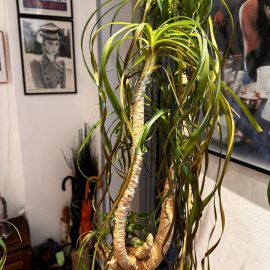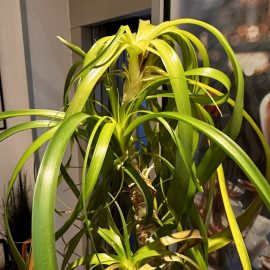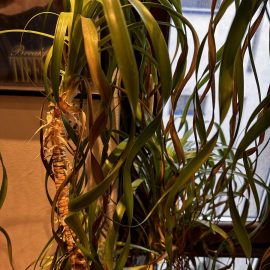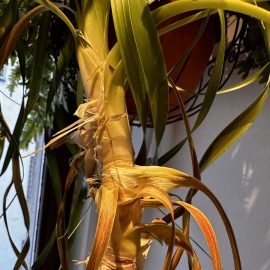Beaucarnea, plant care and growing guide
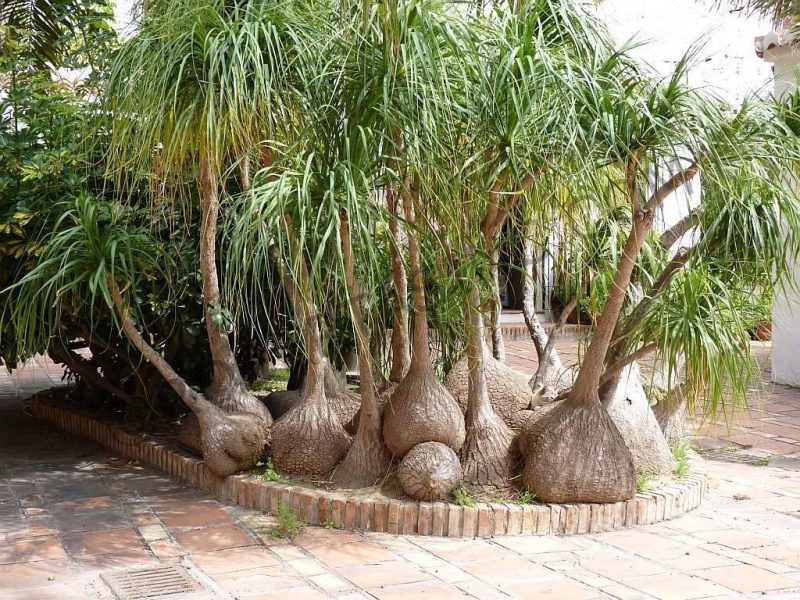
Beaucarnea recurvata is a shrub that belongs to the Asparagaceae family, popularly called “elephant’s foot”, due to its thickened stem towards the base. It is native to Mexico and Central America, on the European continent being used as an indoor decorative plant.
In pots, it has slow growth and it rarely reaches a height of 1.5 m. The stem, similar to palm trees, has an increase in thickness called caudex at the base, with the role of storing water. At the top of the stem are long, thin leaves, arranged in the shape of a bush. It rarely blooms in pots, forming a panicle with small, white flowers.
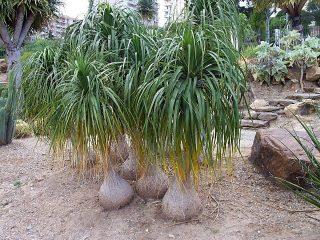
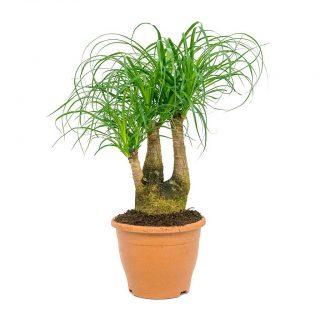
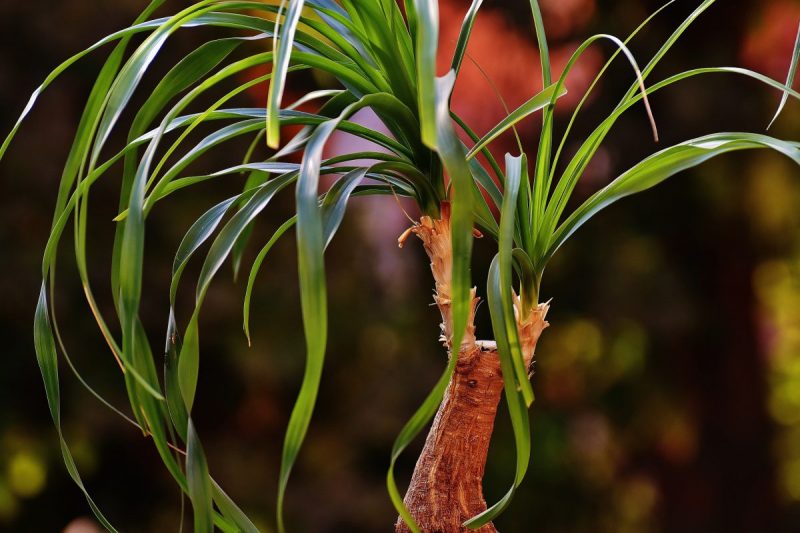
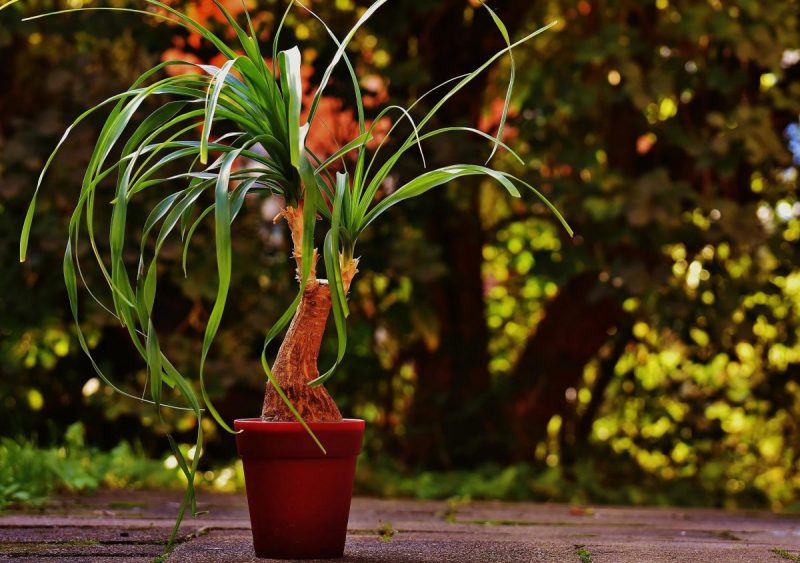
Environmental conditions
Light. Beaucarnea prefers places with strong light, but it should not be placed in direct sunlight.
Temperature. The optimum growth temperature is between 22-24° C. In winter it can be placed in a cooler room, but the temperature should not drop below 8-10° C.
Humidity. It does not have very high requirements regarding atmospheric humidity, but at temperatures higher than 20° C it is recommended to spray the leaves with non-calcareous water.
Substrate. This plant needs a light substrate, with good drainage to avoid water retention, to prevent root rot. It can be specially made for plants in the Ericaceae family, manure, and fine gravel.
Recommended products
-
You can find products on a different store
Change Store -
You can find products on a different store
Change Store -
You can find products on a different store
Change Store -
You can find products on a different store
Change Store -
You can find products on a different store
Change Store -
You can find products on a different store
Change Store -
You can find products on a different store
Change Store -
You can find products on a different store
Change Store -
You can find products on a different store
Change Store -
You can find products on a different store
Change Store -
You can find products on a different store
Change Store -
You can find products on a different store
Change Store -
You can find products on a different store
Change Store -
You can find products on a different store
Change Store -
You can find products on a different store
Change Store -
You can find products on a different store
Change Store -
You can find products on a different store
Change Store -
You can find products on a different store
Change Store -
You can find products on a different store
Change Store -
You can find products on a different store
Change Store -
You can find products on a different store
Change Store -
You can find products on a different store
Change Store -
You can find products on a different store
Change Store -
You can find products on a different store
Change Store
Watering
Beaucarnea is a plant that does not require large amounts of water and that can withstand a lack of water more easily than excessive humidity. In spring and summer, watering is recommended only when the substrate is dry on the surface; in winter it needs to be watered once a month. It is advisable to use water at room temperature because cold water can cause a thermal shock.
Fertilization
It is a plant that does not require fertilization, but in the spring-summer period, a special fertilizer can be added once a month.
Recommended products
-
You can find products on a different store
Change Store -
You can find products on a different store
Change Store -
You can find products on a different store
Change Store -
You can find products on a different store
Change Store -
You can find products on a different store
Change Store -
You can find products on a different store
Change Store -
You can find products on a different store
Change Store -
You can find products on a different store
Change Store -
You can find products on a different store
Change Store -
You can find products on a different store
Change Store -
You can find products on a different store
Change Store -
You can find products on a different store
Change Store -
You can find products on a different store
Change Store -
You can find products on a different store
Change Store -
You can find products on a different store
Change Store -
You can find products on a different store
Change Store -
You can find products on a different store
Change Store -
You can find products on a different store
Change Store -
You can find products on a different store
Change Store -
You can find products on a different store
Change Store -
You can find products on a different store
Change Store -
You can find products on a different store
Change Store -
You can find products on a different store
Change Store -
You can find products on a different store
Change Store
Repotting
Beaucarnea should not be repotted very often, as its thin roots may be affected. You can move the plant to another pot once every 3 years, in March-April. The new pot does not have to be very large, because this shrub grows best in narrow pots.
Propagation
The propagation of Beaucarnea can be done through seeds, which are sown in spring and need temperatures of about 20° C to germinate. It also multiplies through rooting the shoots that appear on the stem in spring.
Recommended products
-
You can find products on a different store
Change Store -
You can find products on a different store
Change Store -
You can find products on a different store
Change Store -
You can find products on a different store
Change Store -
You can find products on a different store
Change Store -
You can find products on a different store
Change Store -
You can find products on a different store
Change Store -
You can find products on a different store
Change Store -
You can find products on a different store
Change Store -
You can find products on a different store
Change Store -
You can find products on a different store
Change Store -
You can find products on a different store
Change Store -
You can find products on a different store
Change Store -
You can find products on a different store
Change Store -
You can find products on a different store
Change Store -
You can find products on a different store
Change Store -
You can find products on a different store
Change Store -
You can find products on a different store
Change Store -
You can find products on a different store
Change Store -
You can find products on a different store
Change Store -
You can find products on a different store
Change Store -
You can find products on a different store
Change Store -
You can find products on a different store
Change Store -
You can find products on a different store
Change Store
Diseases and pests
Mealybugs and mites can infest the plant, which must be treated from the first signs of the attack. The excessive watering and poor drainage of the substrate can cause root rot.
Recommended products
-
You can find products on a different store
Change Store -
You can find products on a different store
Change Store -
You can find products on a different store
Change Store -
You can find products on a different store
Change Store -
You can find products on a different store
Change Store -
You can find products on a different store
Change Store -
You can find products on a different store
Change Store -
You can find products on a different store
Change Store -
You can find products on a different store
Change Store -
You can find products on a different store
Change Store -
You can find products on a different store
Change Store -
You can find products on a different store
Change Store -
You can find products on a different store
Change Store -
You can find products on a different store
Change Store -
You can find products on a different store
Change Store -
You can find products on a different store
Change Store -
You can find products on a different store
Change Store -
You can find products on a different store
Change Store -
You can find products on a different store
Change Store -
You can find products on a different store
Change Store -
You can find products on a different store
Change Store -
You can find products on a different store
Change Store -
You can find products on a different store
Change Store -
You can find products on a different store
Change Store
In addition:
- the drying of the basal leaves is a natural process, which occurs with the aging of the plant and it is recommended to remove them.
- avoid placing the shrub near a south-facing window.
- in winter, during the dormancy period, the plant should not be moved.














































































































































































































































































































































































































































